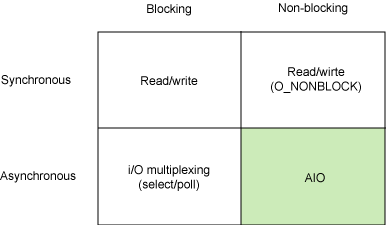Asynchronous IO(AIO)
Java 1.7부터 새롭게 등장한 클래스를 얘기하기 전에
Asynchronous IO에 대해 이해가 필요하다.I/O Model

IBM AIO 관련 내용을 참고하면 위 사진처럼 I/O 모델이 존재한다.
모델을 보고나서 먼저 든 생각은 Synchronous-Blocking? Asynchronous-Non-Blocking? 무슨 차이지라는 생각과 Synchronous인데 Non-Blocking? Asynchronous인데 Blocking?이 무엇이지 라는 생각이 들었다.
그래서 이번기회에 해당 개념을 제대로 이해해 보기 위해 정리해보았다.
Synchronous/Asynchronous
즉 호출된 함수의 작업 결과를 누가 신경쓰는지에 따라 다르다.
Blocking/Non-Blocking
즉 호출된 함수가 작업이 완료될때까지 호출한 함수을 제어권을 통제하는지 마는지에 따라 다르다.
Synchronous/Asynchronous, Blocking/Non-Blocking 예시
아래 이미지는 적절한 예시라 판단되어 여기에서 가져온 내용이다.

그러면 앞서 구현하였던 코드는 어떤 부분에 해당 될까?
I/O 자체는 Channel을 통해 Block이 되지 않고 읽어드리지만 Selector가 하나의 Key 작업이 완료 될때까지 다른 Selector Key들이 해당 Key 작업을 완료여부를 신경쓰고 기다리고 있기 때문에 Synchronous Non-Block 모델에 해당될 것이다.

AsynchronousServerSocketChannel
Java 1.7 등장한 클래스이며 AIO를 지원하는 클래스이다
문서를 참고하여서 간단한 코드를 구현해보자
import java.io.IOException;
import java.net.InetSocketAddress;
import java.nio.ByteBuffer;
import java.nio.channels.AsynchronousChannelGroup;
import java.nio.channels.AsynchronousServerSocketChannel;
import java.nio.channels.AsynchronousSocketChannel;
import java.nio.channels.CompletionHandler;
import java.util.concurrent.Executors;
import java.util.concurrent.TimeUnit;
public class AsyncNio {
AsynchronousChannelGroup channelGroup;
AsynchronousServerSocketChannel asynchronousServerSocketChannel;
private void init() throws IOException {
try {
channelGroup = AsynchronousChannelGroup.withFixedThreadPool(
Runtime.getRuntime().availableProcessors(), Executors.defaultThreadFactory());
asynchronousServerSocketChannel = AsynchronousServerSocketChannel.open(channelGroup);
InetSocketAddress inetSocketAddress = new InetSocketAddress("127.0.0.1", 80);
asynchronousServerSocketChannel.bind(inetSocketAddress);
} catch (IOException e) {
} finally {
}
}
public void startServer() throws IOException {
init();
start();
}
private void start() {
try {
asynchronousServerSocketChannel.accept(null, acceptCompletionHandler(null, asynchronousServerSocketChannel));
} catch(Exception e) {
}
}
private CompletionHandler<AsynchronousSocketChannel, Void> acceptCompletionHandler(String att, AsynchronousServerSocketChannel asynchronousServerSocketChannel) {
return new CompletionHandler<AsynchronousSocketChannel, Void>() {
@Override
public void completed(AsynchronousSocketChannel channel, Void attachment) {
// TODO Auto-generated method stub
ByteBuffer readBuffer = ByteBuffer.allocate(1024);
channel.read(readBuffer, 60, TimeUnit.SECONDS, attachment, channelReadHandler(readBuffer, channel));
readBuffer.rewind();
asynchronousServerSocketChannel.accept(null, acceptCompletionHandler(null, asynchronousServerSocketChannel));
}
@Override
public void failed(Throwable exc, Void attachment) {
}
};
}
private CompletionHandler<Integer, Void> channelReadHandler(ByteBuffer readBuffer, AsynchronousSocketChannel asynchronousSocketChannel) {
return new CompletionHandler<Integer, Void>() {
@Override
public void completed(Integer result, Void attachment) {
// TODO Auto-generated method stub
ByteBuffer byteBuffer = ByteBuffer.allocate(1024);
try {
// biz ....
} catch(Exception e) {
//HTTP 500 error
} finally {
asynchronousSocketChannel.write(byteBuffer, 60, TimeUnit.SECONDS, attachment, channelWriteHandler(byteBuffer, asynchronousSocketChannel));
byteBuffer.rewind();
}
}
@Override
public void failed(Throwable exc, Void attachment) {
//HTTP 503 error
}
};
}
private CompletionHandler<Integer, Void> channelWriteHandler(ByteBuffer writeBuffer, AsynchronousSocketChannel asynchronousSocketChannel) {
return new CompletionHandler<Integer, Void>() {
@Override
public void completed(Integer result, Void attachment) {
// TODO Auto-generated method stub
try {
// biz ....
} catch(IOException e) { }
}
@Override
public void failed(Throwable exc, Void attachment) {
try {
close();
} catch(IOException e) { }
}
};
}
private void close() throws IOException {
asynchronousServerSocketChannel.close();
if(channelGroup != null) channelGroup.shutdown(); channelGroup = null;
}
}
소스를 보면 block되는 곳은 없고 처리는 OS의 비동기를 통해 CompletionHandler로 콜백 처리가 되고 있다.
이러한 흐름을 Proactor패턴이라 부르는데. Proactor패턴은 다음시간에 알아보자.
다음 글엔 Reactor 패턴과 Proactor패턴을 알아보는 내용을 담도록 하겠다
(*Proactor 패턴 :OS의 비동기 I/O를 호출하고 작업이 완료되면 콜백형식으로 받아서 적절한 이벤트를 호출하고 처리하는 구조
다만 리눅스나 유닉스 환경에서는 좋지 못하다.)


배낀 글 감사합니다. BTS 방탄소년단